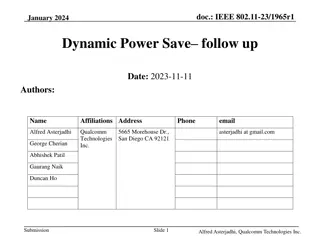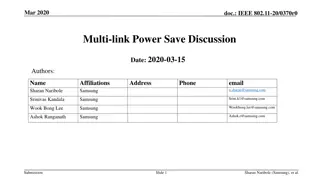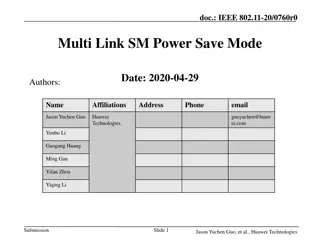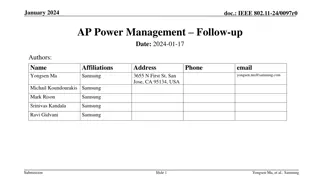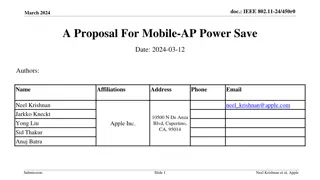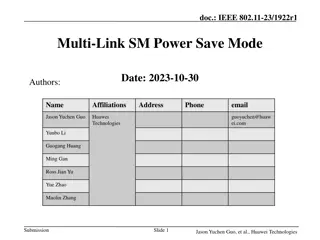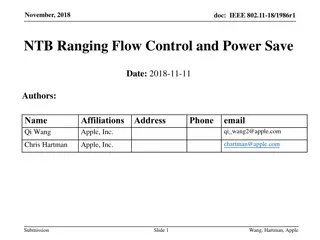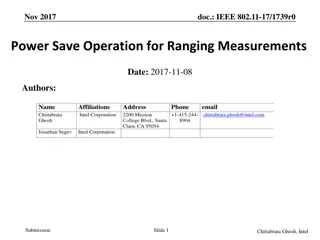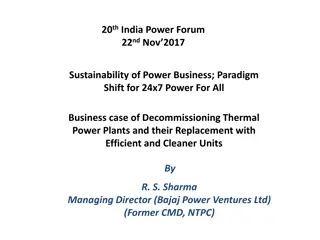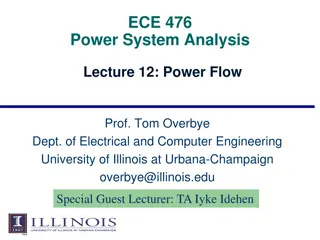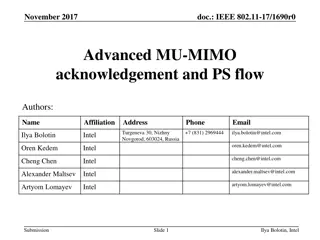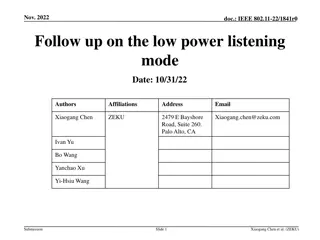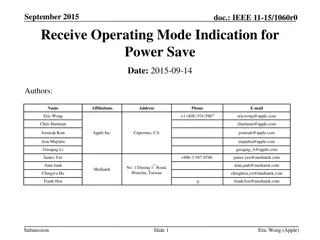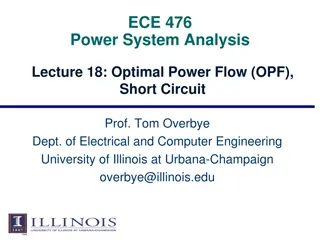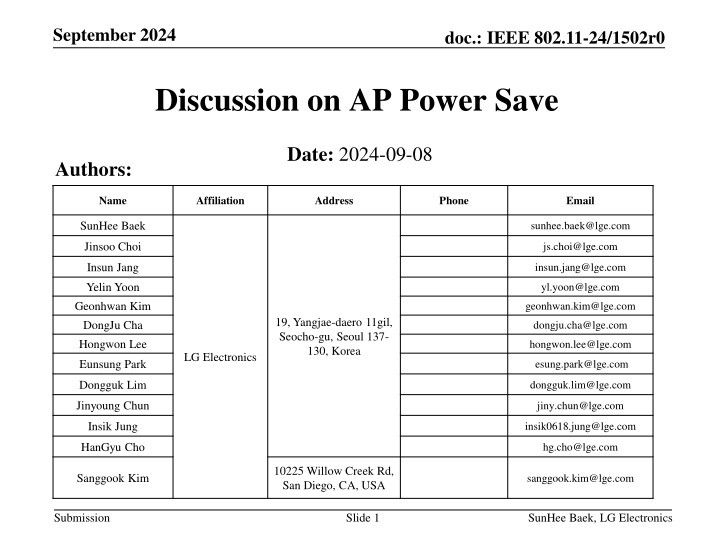
IEEE 802.11-24/1502r0 Discussion on AP Power Save in September 2024
Explore the discussion on AP power saving mechanisms in the context of IEEE 802.11-24/1502r0 document in September 2024. Learn about the challenges associated with excessive energy use in APs, the different power save modes available, and considerations for effective power management strategies.
Download Presentation

Please find below an Image/Link to download the presentation.
The content on the website is provided AS IS for your information and personal use only. It may not be sold, licensed, or shared on other websites without obtaining consent from the author. If you encounter any issues during the download, it is possible that the publisher has removed the file from their server.
You are allowed to download the files provided on this website for personal or commercial use, subject to the condition that they are used lawfully. All files are the property of their respective owners.
The content on the website is provided AS IS for your information and personal use only. It may not be sold, licensed, or shared on other websites without obtaining consent from the author.
E N D
Presentation Transcript
September 2024 doc.: IEEE 802.11-24/1502r0 Discussion on AP Power Save Date: 2024-09-08 Authors: Name Affiliation Address Phone Email SunHee Baek sunhee.baek@lge.com Jinsoo Choi js.choi@lge.com Insun Jang insun.jang@lge.com Yelin Yoon Geonhwan Kim DongJu Cha Hongwon Lee yl.yoon@lge.com geonhwan.kim@lge.com 19, Yangjae-daero 11gil, Seocho-gu, Seoul 137- 130, Korea dongju.cha@lge.com hongwon.lee@lge.com LG Electronics Eunsung Park esung.park@lge.com Dongguk Lim dongguk.lim@lge.com Jinyoung Chun jiny.chun@lge.com Insik Jung insik0618.jung@lge.com HanGyu Cho hg.cho@lge.com 10225 Willow Creek Rd, San Diego, CA, USA Sanggook Kim sanggook.kim@lge.com Submission Slide 1 SunHee Baek, LG Electronics
September 2024 doc.: IEEE 802.11-24/1502r0 Introduction Since AP keeps Active mode all the time, it suffers from excessive energy use as time goes by. For example, the problems can lead to device s components aging and increased costs due to power consumption. With the advent of MLD, solving the energy problems has become urgent. In UHR(11bn), we are discussing that AP supports Power Save mode as well as Active mode[1]-[8]. That is, AP also goes to the doze state from the awake state like non-AP STA. Motion 49) Define a new mechanism and/or enhance existing mechanism for AP power save [9]. In this contribution, we introduce some considerations regarding AP s use of the power save mode based on candidate methods discussed in 11bn. Submission Slide 2 SunHee Baek, LG Electronics
September 2024 doc.: IEEE 802.11-24/1502r0 Recap: AP s state in Power Save mode The AP supporting power save mode can have the following states depending on which mode is either active mode or power save mode. That is, if the AP is in power save mode, it can be in one of two power states; awake state or doze state. For example, the AP is fully powered in awake state. The AP is not able to transmit or receive PPDUs and consumes very low power in doze state. In this contribution, the AP power save modes are focused on the several candidates discussed in UHR. The AP operating the dynamic SP mode listens until it receives the initial control frame(ICF). Submission Slide 3 SunHee Baek, LG Electronics
September 2024 doc.: IEEE 802.11-24/1502r0 AP s Operations based on Power save modes The proposals can reduce AP power consumption for sure during doze state (or listening) We think there are some issues to use only one power save mode among the candidates in various situations. In the case of the scheduled PS mode, The AP is not easy to schedule the service periods for the (urgent) traffic of all associated STAs. Especially, the AP is difficult to schedule the service periods to the STAs not having negotiated particular traffic characteristics like SCS. In the case of the unscheduled PS mode, As the number of requests (e.g., polling) increases, the number of times the AP has to switch states may increase. In the case of the dynamic PS mode, This would be able to compromise the issues of those modes, but (listening) it is relatively difficult to expect a power save effect from the AP being in doze state (especially when IDLE duration is long). Based on the above observations, each power save mode could work properly in several cases, e.g., The scheduled PS mode can operate when the associated STAs have previously performed traffic negotiation. The unscheduled PS mode can operate when the number of STA is few or there is a rule to transmit less polling for a particular traffic to transmit. The dynamic PS mode can operate during awake state at the scheduled and/or unscheduled PS mode. Submission Slide 4 SunHee Baek, LG Electronics
September 2024 doc.: IEEE 802.11-24/1502r0 AP s Operations based on Power save modes Therefore, these candidates can be operated to combine to save AP s power depending on scenarios/situations. For example, depending on the time zone, depending on the number of the associated STAs, etc. Active Scheduled Unscheduled [Enterprise] Unscheduled Scheduled Active [Home] Active Whenever the AP switches its PS mode between the possible AP PS modes, it needs to indicate its mode to the associated STA through the Beacon frame. For example, if an AP switches its PS mode from scheduled PS mode to unscheduled PS mode, it can announce the changed PS mode while the PS mode is still enabled. For example, if an AP affiliated with AP MLD is in PS mode, the other AP affiliated with the same AP MLD in active mode can indicate the AP s current PS mode through RNR. Submission Slide 5 SunHee Baek, LG Electronics
September 2024 doc.: IEEE 802.11-24/1502r0 AP Power Save with Legacy STA We need to consider how the legacy STA should be handled with AP supporting the power saving mode. A legacy STA cannot recognize whether the AP supports the AP power save mode and it is in which state is either awake or doze state. If the AP associated with the legacy STA is in doze state, the STA keeps trying to exchange data frames without knowing why not getting a response. Or, the AP can schedule the quiet intervals whenever it is in doze state. But the method is not efficient and fair to the associated STAs. Therefore, the AP should operate the power save mode only when the associated STA(s) recognizes the indication/announcement related to the AP power save mode. If AP is AP MLD, the legacy STA can associate with the AP affiliated with AP MLD in active mode to operate without problems in advance. We can discuss that the AP power save mode maybe supported to HE/EHT STA in 6 GHz through the responder PM mode with TWT mechanism. Submission Slide 6 SunHee Baek, LG Electronics
September 2024 doc.: IEEE 802.11-24/1502r0 AP Power Save with Legacy STA [Assumption] - AP 1, AP 2, and AP 3 are affiliated with the same AP MLD - The APs support AP power save modes; scheduled, unscheduled, and/or DPS. - The UHR STA means the STA can recognize AP s announcement about the AP power save. Link 1 (2.4Ghz) : AP1 Link 2 (5GHz) : AP2 Link 3 (6GHz) : AP3 CASE 1) Only UHR STAs are exist. The AP power save mode can be operated If HE STA/EHT STA/UHR STA supporting the Broadcast TWT is associated with AP3, the (scheduled) AP power save mode could be operated. If pre-UHR STA and UHR STA is associated with AP1/AP2, the AP power save mode cannot be operated. CASE 2) UHR STA/ pre- UHR STA are exist. NOTE: Depending on the design of AP DPS, pre-UHR STAs may work [10]. In terms of MLD, at least one AP affiliated with AP MLD shall stay in active mode, e.g., To support association with the legacy STA(s). To support transmission the low latency/urgent traffic from the non-AP STA/MLD. Submission Slide 7 SunHee Baek, LG Electronics
September 2024 doc.: IEEE 802.11-24/1502r0 Conclusion In this contribution, we discussed AP power save modes as the candidates (e.g., scheduled, unscheduled, dynamic) discussed in UHR. Depending on scenarios/circumstances, the candidates of power save modes can be switched when the AP is in PS mode. Whenever the AP s PS mode is changed, it shall be announced to the associated STA through the Beacon frame. If an associated STA is a legacy STA that cannot recognize the AP s power save operation, the AP should keep its mode as active mode. But, we can discuss the method(s) defined in the baseline that some legacy STAs can support the operation for the AP power save mode (e.g., Broadcast TWT in 6GHz band). In terms of MLD, at least one AP affiliated with AP MLD should stay in active mode to support frame exchange with legacy STA and low latency traffic transmission. Submission Slide 8 SunHee Baek, LG Electronics
September 2024 doc.: IEEE 802.11-24/1502r0 Straw Poll 1 Do you agree to add the following text to the TGbn SFD? Allow one or more AP(s) affiliated with an AP MLD to support a power saving mode to switch its state between awake state and doze state. How to change the AP s state is TBD. Submission Slide 9 SunHee Baek, LG Electronics
September 2024 doc.: IEEE 802.11-24/1502r0 Straw Poll 2 Do you agree to add the following text to the TGbn SFD? An AP affiliated with an AP MLD shall not operate a power saving mode when at least one STA, which cannot recognize/discover the parameters/information related to the AP power saving mode, is associated with the AP. Submission Slide 10 SunHee Baek, LG Electronics
September 2024 doc.: IEEE 802.11-24/1502r0 References [1] 23/0010, Considerations for enabling AP power save [2] 23/0015, AP MLD Power Management [3] 23/0225, Considering unscheduled AP Power save [4] 23/1936, AP MLD Power Save Follow-up [5] 23/2040, Enabling AP power save Follow up [6] 24/0097, AP Power Management Follow up [7] 24/0352, Enabling Unscheduled AP PS Follow-up [8] 24/0659, Thoughts on AP Power Save [9] 24/0171, TGbn Motions list part 1 [10] 24/0833, Dynamic Power Saving for AP Submission Slide 11 SunHee Baek, LG Electronics



